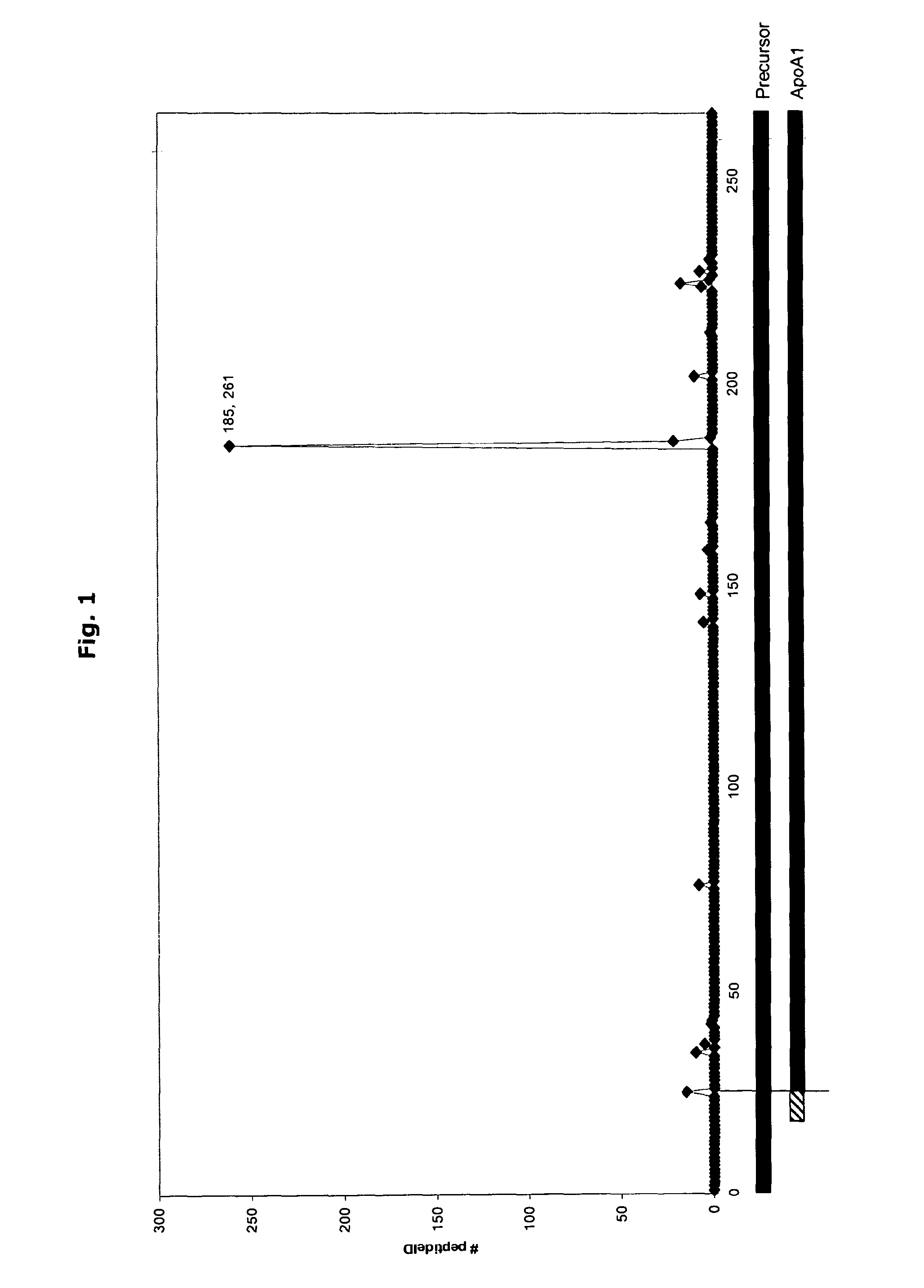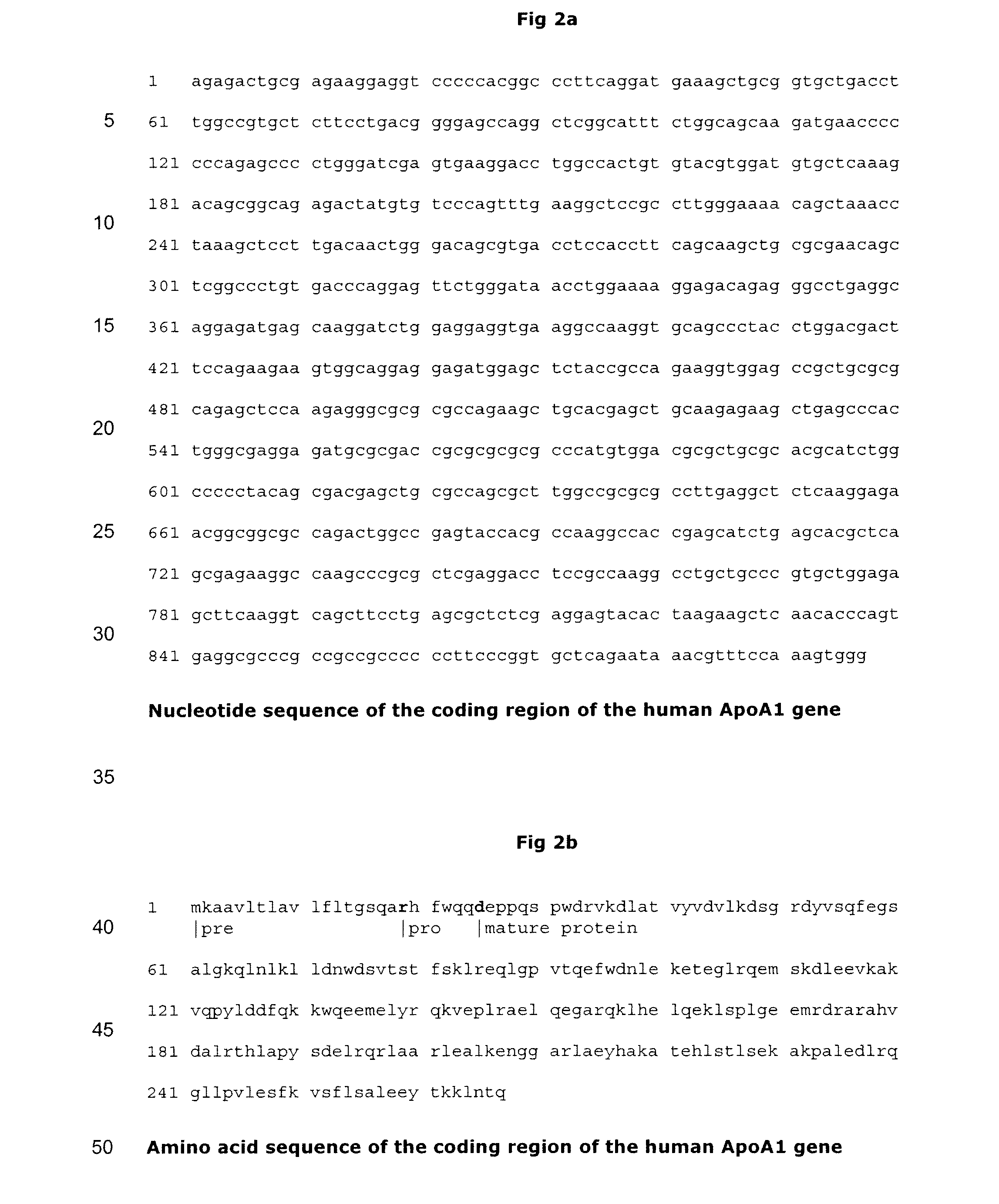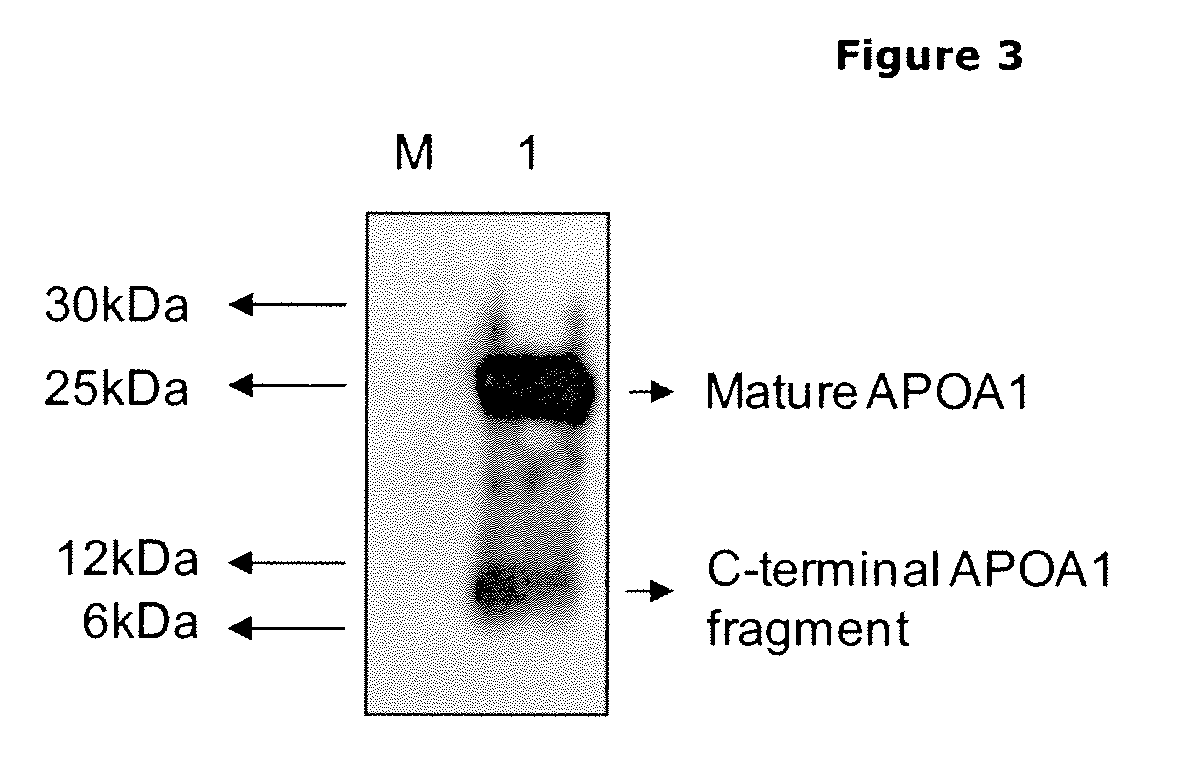Use of n-terminal and c-terminal proteomics technology to enhance protein therapeutics and diagnostics
a technology of c-terminal and n-terminal, which is applied in the preparation of animal/human proteins, peptide preparation methods, apolipeptides, etc., can solve the problems of inactivation of vaccine active protein ingredients, therapeutic or diagnostic compositions, methods that do not correctly identify proteolytic cleavage sites, and complex compositions that are prone to cleavage by proteases, etc., to achieve the effect of reducing the sensitivity of said protein
- Summary
- Abstract
- Description
- Claims
- Application Information
AI Technical Summary
Benefits of technology
Problems solved by technology
Method used
Image
Examples
example 1
N-Terminal Analysis to Detect ApoA1 Processing
[0158]The COFRADIC N-terminal proteomics platform allows us to specifically analyse the N-terminus of a protein (or of a number of proteins), but in addition application of such a strategy also reveals proteolytic processing as these novel N-termini are also readily detected. Application of this platform on a serum sample revealed the occurrence of a novel cleavage event in human Apolipoprotein A1 (Swissprot accession: APOA1_HUMAN) after position R184.
Protocol:
Delipidation and Affinity Removal of 6 Abundant Proteins
[0159]Serum from a healthy volunteer was prepared according to standard procedures. One volume of TBS (100 mM Tris-HCl ph7.4, 150 mM NaCl) and one volume of trichlorotrifluoroethane (Riedel-de-Haen, #34874) are added to a 120 μl serum sample. After vortexing and centrifugation, the delipidated sample is transferred to a new vial and diluted 2.5× with MARS buffer A complemented with protease inhibitors. The sample is depleted w...
example 2a
Western Analysis for ApoA1 Variants in Blood of a Healthy Person
[0166]Using antibodies directed against the N- and C-terminus of ApoA1 in Western analysis, we are able to identify the naturally occurring variants of this protein that can be found in the blood of a normal healthy person. This confirms the data obtained with the N-terminal discovery platform described higher.
Protocol:
[0167]Serum samples from healthy donors (appr. 2 μl or 100 mg) are diluted to 16 ul with Phosphate Buffered Saline (0.2 M Phosphate pH7.4, 150 mM NaCl). 4 μl 5× Loading buffer is added (0.313 M Tris-HCl pH 6.8, 10% SDS, 0.05% bromophenol blue, 50% glycerol). The sample is heated to 99° C., and after cooling loaded on 15% SDS-PAGE gels (Biorad, Tris-HCl ready gel). After separation, the protein material is transferred to Immobilon-PSQ (Millipore) membranes by electroblotting. Membranes are subsequently blocked by milk powder (2%) dissolved in TBS-T (100 mM Tris-HCl pH7.4; 150 mM NaCl; 1 / 1000 Tween20) for 3...
example 2b
Immunological Detection of the C-Terminal Fragment in ApoA-1
[0169]As an alternative detection system to show processing of ApoA-1, we used a classic immunological approach. The AI-4.1 mouse monoclonal antibody detects specifically the ApoA-1 sequence and was obtained by immunization of BALB / c mice with the C-terminal fragment of ApoA-1 obtained after cyanogen bromide cleavage of the protein (Allan C. et al., 1993, Biochem J, 290, 449-455). This fragment corresponds to amino acid sequence 173-267 of the full length ApoA-1 protein. Processing in ApoA-1 occurs at position R184. The size predicted for the C-terminal fragment based on this cleavage is 9.3 kDa.
[0170]Serum obtained from healthy males was pooled and depleted using the Multiple Affinity Removal System (MARS) level I (Agilent) removing the 6 most abundant proteins (albumin, alfa-1-antitrypsin, haptoglobin, IgG, IgA, transferrin). 3× Loading buffer (125 mM Tris-HCl / 4% SDS / 50% glycerol / 0.02% Bromophenol Blue / 10% beta mercaptoet...
PUM
| Property | Measurement | Unit |
|---|---|---|
| volume | aaaaa | aaaaa |
| pH | aaaaa | aaaaa |
| pH | aaaaa | aaaaa |
Abstract
Description
Claims
Application Information
 Login to View More
Login to View More - R&D
- Intellectual Property
- Life Sciences
- Materials
- Tech Scout
- Unparalleled Data Quality
- Higher Quality Content
- 60% Fewer Hallucinations
Browse by: Latest US Patents, China's latest patents, Technical Efficacy Thesaurus, Application Domain, Technology Topic, Popular Technical Reports.
© 2025 PatSnap. All rights reserved.Legal|Privacy policy|Modern Slavery Act Transparency Statement|Sitemap|About US| Contact US: help@patsnap.com



